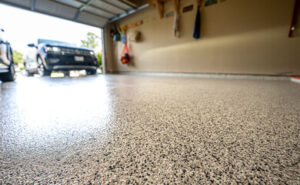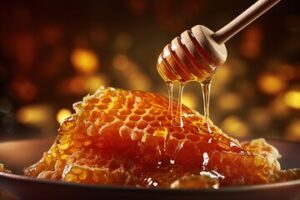Epoxy coatings provide a strong, protective surface that resists damage and can be customized with different colors. However, the extensive concrete preparation, specialized materials, and professional labor can make this flooring option more expensive upfront. Reach out to Garage Flooring Conroe TX for expert assistance.

Interlocking garage floor tiles offer easy DIY installation, which can save time and money. They also come in a variety of patterns and colors to allow you to create unique visual themes.
Epoxy is a highly durable floor coating that comes in many colors and styles to match any garage. It’s also highly slip- and spill-resistant, making it an excellent option for high-traffic areas. If your garage has a high level of exposure to UV rays, however, epoxy can fade or yellow over time. In addition, if the concrete isn’t properly prepped before the application of the epoxy, it can peel and flake.
A popular alternative to epoxy is MMA. Made from methyl methacrylate, MMA floor coatings provide a similar look to epoxy but are extremely durable and resistant to chemicals and gasoline. MMA floor coatings are also anti-static, which means they won’t collect dirt and dust as readily as other types of flooring.
Another floor coating option is a standard commercial-grade concrete sealer. You’ll find this in most hardware stores and is typically inexpensive. These coatings aren’t ideal, though, as they’re only a temporary solution and will need to be reapplied regularly.
Epoxy and polyurea floor coatings both offer several options for color and style to help you make your garage flooring unique and a conversation piece. The advantage to a polyurea floor, however, is that it won’t fade or yellow due to UV exposure like epoxy can.
Both of these floor coatings can be textured with a variety of aggregates to increase their grip and traction. A texture will also reduce the amount of splashback from oil or other chemicals, which is an important consideration in a busy garage.
One major disadvantage to a polyurea floor is that it takes longer than epoxy to cure. This can mean you’ll need to give up your garage for a few days while it solidifies. It is possible to find an epoxy formulation that can withstand cold temperatures and moisture, but this will usually be more expensive.
Both epoxy and polyurea are tough and long-lasting, but it’s important to consider the specific conditions that you live in when choosing a floor covering. For example, if you park your car in the same spot in the garage each day during the summer, it can cause the underside of the tires to melt the epoxy coating. Polyaspartic is not susceptible to this, which can make it a better choice for garages that receive a lot of traffic from cars.
Tiles
Tiles are the simplest flooring option for your garage, offering style and durability. They come in a wide variety of colors and designs, making it easy to match your garage décor. Tiles are also resistant to stains, spills, mildew formation, and moisture, and can be easily cleaned with a damp mop or sponge. They are also durable and sturdy, able to stand up to heavy loads and car jacks.
Interlocking tiles can be a good choice for a residential garage, as they are quick and relatively inexpensive to install. They can be made from plastic, PVC, or rubber materials. Plastic garage floor tiles produce a clean aesthetic, while rubber garage floor tiles are softer and absorb movement for a forgiving modular garage surface. Interlocking tiles also offer the flexibility to rearrange them and create custom patterns for a more unique look.
When choosing tiles, be sure to match their size to your space. Smaller tiles can make a room appear smaller, while larger ones create a more spacious environment. Also, be aware that some tiles can leave gaps between them, which can trap dirt and debris and allow mold and mildew to grow.
Many garage floor tile brands, such as RaceDeck and Swisstrack, have online design tools that let you plug in your measurements and find the perfect tile for your space. When installing, remember to account for any areas where you will need a ramp to drive onto the floor. Also, if you plan to park cars in your garage, be sure to choose car-jack approved tiles, which are designed to withstand the heavy loads and pressure of vehicle jacks.
Another common type of flooring for garages is peel-and-stick tiles. These are typically made from heavy-duty vinyl and can be a less expensive alternative to interlocking tiles. However, they are not as long-lasting or durable as other types of floors. Moreover, the adhesive may not be as strong, and they can easily become detached from the concrete. If you decide to go with this option, be sure to thoroughly clean your garage floor and let it dry before installation.
Epoxy
Epoxy is a thick, protective coating that provides a smooth and attractive finish. It comes in a wide range of colors and is available in a number of different styles. It is an ideal option for garages that require a hard-wearing surface, as it resists scratching and marring and can withstand the impact of vehicles. Epoxy also provides a good thermal barrier and helps to insulate the floor, which can help to reduce energy costs.
Before applying epoxy, it is important to ensure that the garage is clear and free of debris. The floor should be swept thoroughly and any oil or grease stains removed with a degreaser. It is also recommended that the floor be hosed down and left to dry completely. This process will vary depending on the product you choose, so it is essential to follow the specific instructions.
Once the floor has been prepared, it is essential to apply the epoxy coating in a well-ventilated area. It is a good idea to wear a mask during the application process to avoid breathing in any silica particles. It is also a good idea to use painter’s tape along the walls and ceilings to protect them from any spilled epoxy.
It is also a good idea to work in small sections when applying the epoxy. This will help to prevent any dripping and ensure that the sections are evenly coated. Once the first coat has been applied, it is a good idea to wait about 12 hours before applying a second coat. It is also a good idea to keep the garage well-ventilated throughout the application and initial curing process.
After applying the final coat, it is a good idea to apply color flakes to the epoxy. This will give the floor a unique appearance and help to draw attention away from any remaining cracks or imperfections. These flakes are available in a variety of sizes and color options, so there is sure to be one that is perfect for your garage. The flakes can also be mixed with the final coat to create an interesting pattern.
Rubber
Rubber garage flooring provides a tough, impact-resistant covering that protects your concrete floor from damage caused by heavy vehicles, home improvement equipment and household chemicals. It also resists moisture and won’t harbor mold. It’s easy to clean, requires no glues and is anti-slip. The only drawback is that it can make your garage feel cold, but a well-insulated door will help. Rubber is also available in tiles with interlocking borders for easy DIY installation (look for products like Eco-Lock Isometric Blue Rubber Gym/Weight Room Flooring Tiles selling for $2.99 per square foot at Home Depot) and rolls that can be cut to size for larger spaces.
Interlocking tiles allow for flexibility and customization, so you can transform your garage into a space that suits your personal style. They can be arranged into checkered or solid-color patterns and are simple to move if you decide to change your mind about the layout. They are also very durable, resistant to stains and spills and can hold up against abrasion. Some come with anti-skid textures to prevent accidents.
A sealer is another affordable option that doesn’t require any floor preparation and can be applied with a roller or sprayer. It dries to a glossy finish and will last for about three years before it needs reapplying. However, it’s not as durable as epoxy and doesn’t guard against chemical damage or UV rays.
If you’re looking for a quick, temporary fix, consider mats. These roll-out flooring solutions are inexpensive, easy to install and can be replaced if they wear out. They don’t offer as much padding or resistance to abrasion as other options, but they do offer a flexible and water-resistant cover for your garage floor that will shield it from abrasions and moisture.
For a more permanent solution, choose rolled rubber. It’s easier to lay than tiles and is available in custom-cut lengths, so you don’t have to worry about seams or wasted material. It’s a great choice for garages that are used to store vehicles and large pieces of equipment, or for families that use the garage as a playroom or impromptu gym. The thicker varieties can even suppress sound and vibration, making them a good fit for commercial or professional garages as well.

